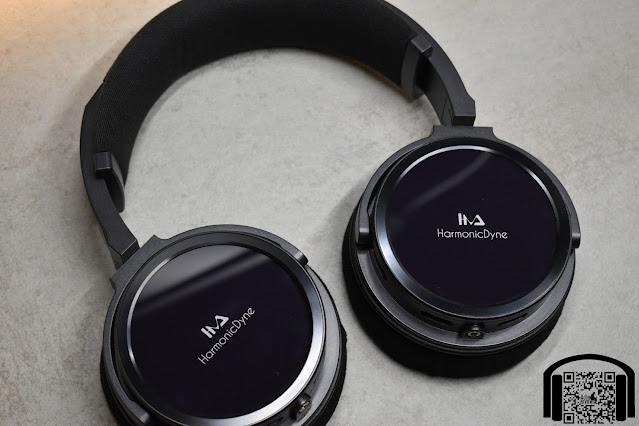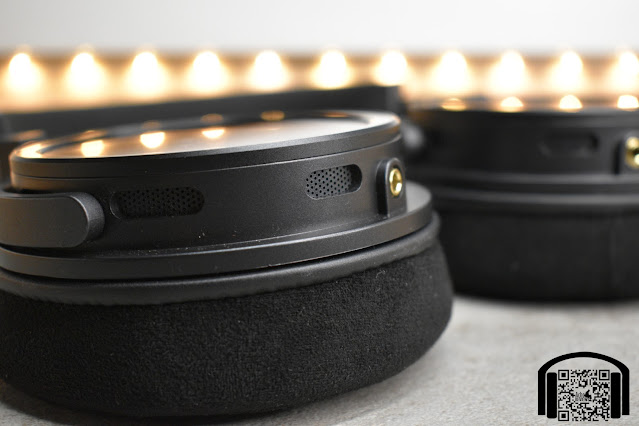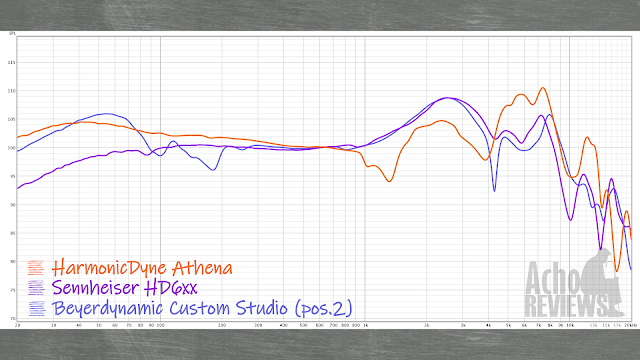- Get link
- X
- Other Apps
English | Español
TLDR version on YouTube: TDLR - HarmonicDyne Athena
The HarmonicDyne Athena have been sent to me by Linsoul in exchange for the publication of this review. Linsoul have not made any comments or special requests and, as always, I will do my best to be as sincere and unbiased as possible.
The Athena can be found via Linsoul here: https://www.linsoul.com/products/harmonicdyne-athena
As with all the links I post, this is a non-affiliate link.
To avoid being repetetive in my reviews, you can find all the info about how I create the reviews, equipment used, how I receive the products and how to interpret my reviews by visiting: About my reviews
Intro…
I have received a few over-ear headphones recently, which is something that I am happy about as I have nothing against IEMs but I do prefer headphones, at least when it is not summer (which will be here soon, as we are already hitting 30ºC during the day).
The HarmonicDyne Athena are a set of closed back headphones (well, semi closed actually) from the brand and they cost just under 180€ via Linsoul at the time of putting this review together. These are the first HarmonicDyne headphones I have tried but I am always looking out for a decent closed back set and if they are budget orientated, even better.
They are marketed as being a “Studio-Grade 50mm Metal-Ceramic Composite Dynamic Driver Headphone” which has a “Studio-Grade Tuning with a tonally balanced sound signature and a 3dB sub-bass boost”. Now, “Studio Grade” can mean just about anything, it is like putting “Pro” on a product. There are big differences between what is needed in a studio for vocal tracking, drum tracking and mixing or mastering (although I still maintain that you can produce music with almost any headphone, as long as you get to know it well and learn how it translates onto other systems). So, let’s see what we actually get in these sub 200€ headphones and if they are worth the investment.
Presentation…
They are presented in a large blue box that shows the HarmonicDyne logo on the top, which opens to the left and reveals the model on another cover that then opens to the right.
Once open we are greeted by the headphones sitting inside some foam cutouts, with an accessories box at the top and in the center we get a brass coin that has the company logo on one side and Athena on the other, along with the serial number. It is not the first coin I have received with an audio product lately but it is a interesting way of providing the serial number.
In my case, the foam layers inside the box are coming unglued, which doesn’t exactly give the packaging a premium feel but the headphones are well protected.
Other that the coin and the headphones, we also get the cable (more on that in a second), a leather cable tie and a drawstring bag for storage. It would have been nice to get a storage case that is a little more protective than the bag, especially as the headphones lay flat, but as long as the savings have gone into the headphones themselves, then I am not complaining.
Build and aesthetics…
The headphones are built almost completely of plastic but aren’t really cheap feeling. I wouldn’t say they feel like a luxury item but the plastic seems to be of decent quality, well assembled, and they don’t creak each time the are moved like some other alternatives do.
The internal part of the headband is metal, with the adjustment sliding inside a plastic cover which feels sturdy and, although only time will tell, should cause much issues. The yolks and cups are also plastic but again, they seem to be well manufactured and I can’t see anything standing out as a “this will definitely break” point. The two clips that hold the padded part of the headband on to the structure are the only part that looks a little “delicate” to me but I don’t think this is something you will be removing often anyway.
At a simple glance, the Athena look like closed back headphones, however, around the circumference of the cups, there are plenty of large vents, making these semi-open (or semi-closed, however you want to look at it).
The included cable is very nice, with braided fabric covered cores, and although the clear plastic parts surrounding the hardware don’t have the best finish to them, I have to say that this is one of the better cables I received with a set of headphones, especially in the budget category.
Sound…
All tracks mentioned are clickable links that allow you to open the reference track in the streaming service of your choice (YouTube, Tidal, Qobuz, Spotify, etc.)
Now on to the important part, how the Athena performs sonically. But first the usual look at the graph, with the HD6XX as a reference point and also the Beyerdynamic Custom Studio Pro (which is a closed back headphone but I don't have any semi-closed on hand).
Starting off in the subbass with the usual “Chameleon” test, there is no roll off in these ranges, in fact, there is a little bit of a bump, which does give these a “rumble” factor. The problem is that it seems there are some reflections going on in the cups which case that rumble to come across as fatiguing, at least to me.
The same sensation is present when listening to “Royals”. It is like a live event where the delays are not quite aligned properly, almost but not exactly, which is what leads me to believe it is a case of reflections inside the cups that is causing this sensation.
Moving into the midbass, this sensation is less present (although there are still hints) and these regions have a hint of warmth to them without being overly exaggerated. When listening to tracks like “No Sanctuary Here” or even “Bombtrack” (which is obviously less electronic), they do come across as being a little bass heavy but that is more related to the higher mid ranges (which I will get to in a moment). Midbass is not the cleanest, partly due to that sensation of reflections but also in part to the fact that the dynamic driver is not the fastest to react to busy passages. For example, in “The Room”, the bass and lower end of the guitar can seem to blend together and not come across as clean individual instruments.
Into the mid range the bottom half is not terrible as we move past the 1kHz region, there is a large dip that never really comes back until we are into the higher ranges. This takes away a lot of presence of vocals and the upper mid range of things like electric guitars, giving the headphones a much more muted and overly dampened sound.
I know I don’t usually refer to EQ in my reviews but I did play around with some simple equalization in the 1kHz to 4kHz range to see what the response was like and I have to say that it really brought more life to these headphones. It even mitigated that sensation of cup reflection in the low ranges due to the fact that with more presence in the upper ranges, especially mids, it made things sound much cleaner and the lower bass notes were no longer the center of attention.
Moving into the treble regions, there is much more presence than in the 1kHz to 4kHz range which is an attempt to bring some more air and clarity to the overall sound. This works to some extent and also manages to not come across as too sibilant, yet it is not enough to overcome that sensation of things being veiled. I actually found that if EQ’ing those higher mids, then I preferred to drop the upper ranges.
Details are difficult to judge due to the overall signature of these headphones but if equalized properly, I feel that the driver is capable of more than it gives in this regard, even if it is not the fastest of drivers in the bass ranges (but again, that could be the reflections causing that sensation).
Soundstage is actually not bad for a set of closed (ok, semi closed) headphones. It is not on the level of open back alternatives and the image placement is not as accurate as some of those either, but it is good enough.
And while touching on the “semi” closed aspect of these headphones, they are a lot more open than one would think. There are a lot of vents around the outside of the cups, making the sound leak quite a bit and also stopping them from isolating as well as one would expect if looking for a closed back set.
Conclusion…
I personally think that HarmonicDyne have made it difficult for themselves with this set of headphones. They have opted for something that seems to aim towards being a closed back set of headphones, yet due to the vents, it doesn’t have the benefits of a true closed back. At the same time, opting for closing the back of the cups has put them in a position of having to work against one of the biggest issues of closed backs.
I do feel that these headphones have potential, as with some EQ they transform in a very positive manner, but in their stock tuning, they just don’t work for me. I mentioned in my review of the Thieaudio Ghost recently that they weren’t really exciting but were more of a blank canvas which could be tailored with some EQ. In the case of the Athena, I find that the EQ is not needed to tailor it to preference but rather to fix the issues that are present. I know that the Ghost are completely open back, so the comparison is not fair, but the choice of closing the cups was made by HarmonicDyne, seemingly to later introduce vents that actually remove the few benefits of a closed back set.
They are comfortable and are easy to drive, so I actually think that if they were paired with a Quedelix 5K, which has onboard PEQ, they could make a very good set of BT headphones. Or if you are using them at a desk and are willing to do some EQ, then they are certainly not bad, but in their stock form, I just can’t see them as a choice above other alternatives at even lower price points.
All FR measurements of IEMs can be viewed and compared on achoreviews.squig.link
All isolation measurements of IEMs can be found on achoreviews.squig.link/isolation
To comment or contact, visit any of the following social media platforms:
- Get link
- X
- Other Apps







